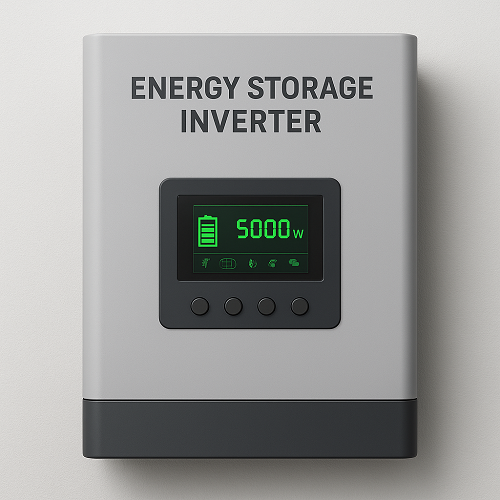The global push toward renewable energy and sustainable power solutions has accelerated the demand for advanced energy storage technologies. Central to this evolution is the energy storage inverter (ESI), a crucial component that bridges energy storage systems and electrical loads.
Understanding Energy Storage Inverters
An energy storage inverter is an electronic device that converts direct current (DC) electricity stored in batteries or other storage mediums into alternating current (AC) electricity that can be used by home appliances, commercial facilities, or fed back into the grid. Unlike traditional inverters, which primarily focus on converting power, energy storage inverters integrate energy management capabilities, allowing for charging, discharging, and grid interaction.
At its core, an energy storage inverter manages three primary functions:
- DC to AC Conversion: Enables stored energy to power AC loads.
- AC to DC Conversion: Allows energy from renewable sources (like solar panels) or the grid to charge batteries.
- Energy Flow Control: Optimizes when and how energy is stored or utilized based on demand, cost, and grid conditions.
Key Components of Energy Storage Inverters
An energy storage inverter typically comprises the following components:
- Power Electronic Modules: These handle the conversion between DC and AC power efficiently, minimizing energy losses.
- Battery Management Interface: Ensures batteries are charged and discharged safely, prolonging their lifespan.
- Control System & Software: Facilitates real-time monitoring, predictive analytics, and energy optimization.
- Grid Connection & Protection Systems: Protects the inverter and grid from anomalies, ensuring compliance with regulations.
Types of Energy Storage Inverters
Energy storage inverters can be classified based on topology and application:
Single-Phase vs. Three-Phase Inverters
- Single-Phase: Commonly used in residential settings with moderate energy storage requirements.
- Three-Phase: Suited for commercial or utility-scale systems with higher capacity and load demands.
Hybrid Inverters
- Integrate solar PV systems with battery storage.
- Can seamlessly switch between using solar, battery, or grid power depending on availability and cost.
Stand-Alone Inverters
- Operate independently of the grid.
- Ideal for off-grid or remote locations, ensuring uninterrupted power supply.
Bidirectional Inverters
- Enable energy to flow both from storage to load and from the grid to storage.
- Essential for applications like peak shaving, load shifting, and frequency regulation.
Applications of Energy Storage Inverters
Energy storage inverters are versatile and find applications across multiple sectors:
- Residential Energy Storage Systems: Homeowners can store excess solar energy and use it during peak demand or outages, reducing electricity bills and enhancing energy independence.
- Commercial and Industrial Facilities: Businesses leverage ESIs for peak shaving (reducing peak demand charges) and backup power during outages.
- Grid-Scale Energy Storage: Utility companies deploy large-scale inverters to stabilize the grid, manage load fluctuations, and integrate renewable energy sources efficiently.
- Electric Vehicle (EV) Integration: Bidirectional inverters facilitate vehicle-to-grid (V2G) applications, allowing EVs to act as mobile energy storage units.
Advantages of Energy Storage Inverters
The adoption of energy storage inverters brings several tangible benefits:
- Energy Independence: Users can store surplus energy and reduce reliance on the grid.
- Cost Optimization: Dynamic energy management allows for lower electricity bills through load shifting and peak shaving.
- Grid Stability: Supports renewable energy integration and reduces grid stress.
- Backup Power: Ensures uninterrupted electricity supply during outages.
- Sustainability: Enhances the utilization of clean energy, reducing carbon emissions.
Emerging Trends in Energy Storage Inverters
Energy storage inverters are evolving rapidly due to technological advancements and market demand:
- Smart Energy Management: Integration with IoT and AI allows predictive energy storage and usage optimization.
- Scalability and Modularity: Modular inverters allow incremental capacity expansion, making large-scale deployment more flexible.
- Higher Efficiency and Reliability: Next-generation inverters are achieving conversion efficiencies exceeding 98%, minimizing energy losses.
- Hybrid Microgrids: Energy storage inverters are becoming central to microgrid solutions that combine renewable generation, storage, and intelligent load management.
- Integration with Renewable Incentives: Government policies and subsidies increasingly favor storage-ready systems, accelerating inverter adoption.
Energy storage inverters are more than just power converters—they are the brains and arteries of modern energy storage systems. By enabling efficient energy conversion, storage, and management, ESIs are empowering residential, commercial, and utility-scale systems to harness renewable energy effectively. As the global energy landscape shifts toward sustainability, these inverters will continue to play a pivotal role in ensuring reliable, cost-effective, and environmentally friendly power for the future.
































